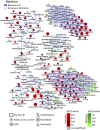Metabolomics and transcriptomics identify pathway differences between visceral and subcutaneous adipose tissue in colorectal cancer patients: the ColoCare study
- PMID: 26156741
- PMCID: PMC4515859
- DOI: 10.3945/ajcn.114.103804
Metabolomics and transcriptomics identify pathway differences between visceral and subcutaneous adipose tissue in colorectal cancer patients: the ColoCare study
Abstract
Background: Metabolic and transcriptomic differences between visceral adipose tissue (VAT) and subcutaneous adipose tissue (SAT) compartments, particularly in the context of obesity, may play a role in colorectal carcinogenesis. We investigated the differential functions of their metabolic compositions.
Objectives: Biochemical differences between adipose tissues (VAT compared with SAT) in patients with colorectal carcinoma (CRC) were investigated by using mass spectrometry metabolomics and gene expression profiling. Metabolite compositions were compared between VAT, SAT, and serum metabolites. The relation between patients' tumor stage and metabolic profiles was assessed.
Design: Presurgery blood and paired VAT and SAT samples during tumor surgery were obtained from 59 CRC patients (tumor stages I-IV) of the ColoCare cohort. Gas chromatography time-of-flight mass spectrometry and liquid chromatography quadrupole time-of-flight mass spectrometry were used to measure 1065 metabolites in adipose tissue (333 identified compounds) and 1810 metabolites in serum (467 identified compounds). Adipose tissue gene expression was measured by using Illumina's HumanHT-12 Expression BeadChips.
Results: Compared with SAT, VAT displayed elevated markers of inflammatory lipid metabolism, free arachidonic acid, phospholipases (PLA2G10), and prostaglandin synthesis-related enzymes (PTGD/PTGS2S). Plasmalogen concentrations were lower in VAT than in SAT, which was supported by lower gene expression of FAR1, the rate-limiting enzyme for ether-lipid synthesis in VAT. Serum sphingomyelin concentrations were inversely correlated (P = 0.0001) with SAT adipose triglycerides. Logistic regression identified lipids in patients' adipose tissues, which were associated with CRC tumor stage.
Conclusions: As one of the first studies, we comprehensively assessed differences in metabolic, lipidomic, and transcriptomic profiles between paired human VAT and SAT and their association with CRC tumor stage. We identified markers of inflammation in VAT, which supports prior evidence regarding the role of visceral adiposity and cancer.
Trial registration: ClinicalTrials.gov NCT02328677.
Keywords: adipose tissue; colorectal cancer; inflammation; metabolomics; obesity; visceral adiposity.
© 2015 American Society for Nutrition.
Figures



References
-
- Wu S, Liu J, Wang X, Li M, Gan Y, Tang Y. Association of obesity and overweight with overall survival in colorectal cancer patients: a meta-analysis of 29 studies. Cancer Causes Control 2014;25:1489–502. - PubMed
-
- van Kruijsdijk RC, van der Wall E, Visseren FL. Obesity and cancer: the role of dysfunctional adipose tissue. Cancer Epidemiol Biomarkers Prev 2009;18:2569–78. - PubMed
-
- Bastard JP, Maachi M, Lagathu C, Kim MJ, Caron M, Vidal H, Capeau J, Feve B. Recent advances in the relationship between obesity, inflammation, and insulin resistance. Eur Cytokine Netw 2006;17:4–12. - PubMed
-
- Ibrahim MM. Subcutaneous and visceral adipose tissue: structural and functional differences. Obes Rev 2010;11:11–8. - PubMed
-
- Fox CS, Massaro JM, Hoffmann U, Pou KM, Maurovich-Horvat P, Liu CY, Vasan RS, Murabito JM, Meigs JB, Cupples LA, et al. . Abdominal visceral and subcutaneous adipose tissue compartments: association with metabolic risk factors in the Framingham Heart Study. Circulation 2007;116:39–48. - PubMed
Publication types
MeSH terms
Substances
Associated data
Grants and funding
LinkOut - more resources
Full Text Sources
Other Literature Sources
Medical
Research Materials

